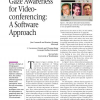Free Online Productivity Tools
i2Speak
i2Symbol
i2OCR
iTex2Img
iWeb2Print
iWeb2Shot
i2Type
iPdf2Split
iPdf2Merge
i2Bopomofo
i2Arabic
i2Style
i2Image
i2PDF
iLatex2Rtf
Sci2ools
IEEEMM
2000
2000
Gaze Awareness for Video-Conferencing: A Software Approach
reness has more abstract social value: People who use frequent eye contact are perceived as more attentive, friendly, cooperative, confident, mature, and sincere than those who avoid it. Despite the obvious importance of directed gaze, most videoconferencing systems make it impossible for participants to make eye contact or even to determine where or at what the other participants are looking. This loss of gaze awareness has a profound impact on communication, and may in fact be a contributing factor in the failure of videoconferencing to meet with its long-anticipated success (for more on this, see the sidebar, "Videoconferencing Research" on page 28). The lack of gaze awareness in typical videoconferencing systems stems from the fact that when participants look at each other, they stare into their displays rather than into the camera, which is typically mounted above, below, or beside the display. Unless people look directly into the camera, you will never perceive them as ...
Eye Contact | Gaze | IEEEMM 2000 | Videoconferencing |
| Added | 18 Dec 2010 |
| Updated | 18 Dec 2010 |
| Type | Journal |
| Year | 2000 |
| Where | IEEEMM |
| Authors | Jim Gemmell, Kentaro Toyama, C. Lawrence Zitnick, Thomas Kang, Steven M. Seitz |
Comments (0)

